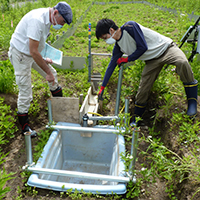 Researchers are seeking to understand what drives transport of radioactive material from the tree to the soil, through and across the soil, and eventually into agricultural crops and water resources
Researchers are seeking to understand what drives transport of radioactive material from the tree to the soil, through and across the soil, and eventually into agricultural crops and water resources
Research at the University of Liverpool is developing new sensors that will help the recovery and regeneration of the post-disaster Fukushima region and pave the way for improved monitoring and control of radioactivity at nuclear sites worldwide.
The new research, funded by the Natural Environment Research Council (NERC), will develop ways to detect, measure and monitor nuclear radiation in the environment so that a radioactive substance beneath the ground can be located and monitored at higher resolution than previously.
Continued release
The continued releases of radioactive material from the earthquake-damaged Fukushima Dai-ichi nuclear power station in Japan, with the risks to water, coastal environments, agricultural land, animals and human health, have drawn international concern.
As a result of this, the University team, which is made up of engineers, environmental scientists and physicists, aims to develop smaller and more accurate versions of detectors known as Compton-geometry sensors. The aim is to see how radioactivity moves with changes in water flow or sediment movement, and how the radiation in contaminated soil gets into the food chain through plants and animals.
 The new imaging sensor has the potential to significantly increase speed and scope, allowing more detailed measurements and more flexible experiment designs
The new imaging sensor has the potential to significantly increase speed and scope, allowing more detailed measurements and more flexible experiment designs
Dr Andrew Boston, from the Department of Physics, is responsible for the Compton-geometry sensors programme at Liverpool which has been supported in the last few years by funding from the Science and Technology Facilities Council (STFC). He said: “These sensors can find the source of radiation with much greater accuracy and sensitivity. They have the advantage of being able to locate the source in 3D and our ultimate goal is to develop smaller, lighter detector equipment with potential savings in measurement time.”
When fully developed, these will be the first cameras of this type which can be used in environments other than industrial and medical facilities. This makes them ideal for use at the sites like Fukushima. One the project partners, Dr James Cooper from the School of Environmental Sciences, has a long-standing collaboration with Tsukuba University, which is leading the major Japanese government funded environmental research programme in the Fukushima region.
Continuous improvement of sensors
The lead researcher on the Liverpool project, Dr Jonathan Bridge from the School of Engineering said: “If we are to measure environmental radioactivity, not just after an accidental release, but also to monitor sites, prevent releases and support the safe operation of nuclear facilities, then we need continuous improvement of sensors which can detect and quantify radiation sources to higher resolution, lower detection thresholds and shorter measurement times.”
The 12-month proof-of-concept project is worth £155,000 and will underpin a long-term programme of inter-disciplinary work across the University and with partners in Japan.
